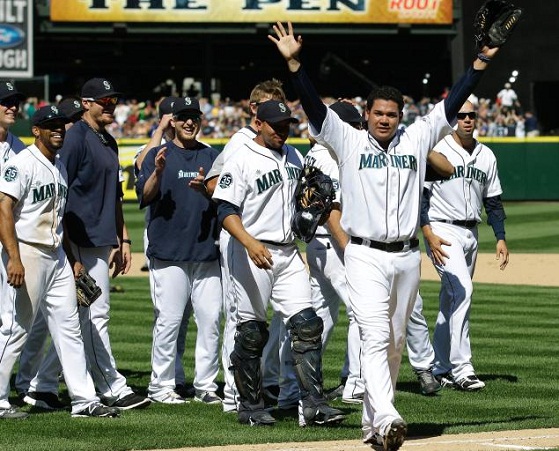By now, most of you know earlier this week Felix Hernandez of the Seattle Mariners became the 23rd pitcher in major league history to throw a perfect game.
 |
| Photo by: Ted S. Warren |
If you are a math (and baseball) geek like myself, you realize that this means almost 1/8 of all perfect games IN HISTORY have been thrown this year. And when you add in the two thrown in 2010 and the one in 2009, you realize that more than 1/4 of all perfect games have been thrown in the past four years. That is staggering!
There has to be a reason for this "Era of the Pitcher," right?
Many would speculate that it coincides with the end of the steroid era. Maybe, but not likely. Steroids were more responsible for home runs, not hits in general.
Some believe that umpires are worse, with ever-widening strike zones. That can't be it though. Umps have always been blind.
The most logical explanation is three-fold.
First, baseball has become diluted to the point that many teams now have guys starting that in the 40s and 50s -- baseball's heyday -- wouldn't have made some Triple A teams.
Again, let's look at the math. Baseball had 16 teams from the early 20th Century until expansion in 1961. Once expansion started, it didn't stop until it hit its current total of 30 teams. Figuring a 25-man roster, that means during baseball's glory days there were 400 major league players, with about 240 of them hitters. Now, you have 750 players, with about 450 hitters. For those who don't like math, that's a 87.5% increase in hitters.
Do you really think that doesn't dilute the talent pool?
Since the turn of the century until expansion in the early 1960s, hitters ruled the roost of major league baseball. It's no coincidence that most of the greatest hitting feats took place during that time -- Babe Ruth's 60 HRs, Joe DiMaggio's 56 game hitting streak, Ted Williams .406 batting average. Even Roger Maris' 61 HRs took place just as expansion started in 1961.
It's been a pitcher's league since then (with the exception of the steroid years). Sandy Koufax pitched four no-hitters, one every year from 1962-1965. Nolan Ryan pitched an unbelievable seven no-no's during the 70s, 80s and early 90s, all while setting the major league record for strikeouts. Speaking of K's, of the top 20 all-time strikeout leaders, only two (Walter Johnson and Cy Young) played significant time before 1960. Jim Bunning played five of his years in the late 50s, but most of his years were in the 60s and 70s.
Second, pitchers have become so specialized, and so many starters are on a pitch count, they stay fresher much deeper into the season. Take a look at the number of innings pitched by guys in the middle of the 1900s. Some of them doubled the innings total of today's starter. When hitters see a starter for less innings, they learn less about what he likes to go to in every situation, and hitting becomes tougher.
And third, well...chicks dig the long ball. Today's hitters ALL seem to think they are power hitters, using that "all-or-nothing" mentality. Strikeouts are up, walks are down, hitters swing for the fences and aren't very selective at the plate. See how many of today's hitters use the ol' "choke-and-poke" approach when they get two strikes on them. None. Zip. Zero. They are still looking for a 3-run bomb on a 1-2 count.
So my guess is, this whole pitching boom the past several years is less about "perfect" pitchers, and more about less-than-perfect hitters.

It's definitely because hitting has become diluted due to expansion. Look at some of the lineups that the perfect games have been thrown against in the past 3-4 years. With the exception of the Rays, they were awful. I think the pitchers back in baseball's earlier years probably had better overall stuff, but hitters saw them more often, so it made it a little easier to get used to them.
ReplyDeleteI think pitchers just get more rest now then they did back in the day, so they are fresher long over the course of the season. Makes them tougher to hit.
ReplyDeleteVery good points! I never thought about it, but these theories make a lot of sense.
ReplyDeleteI think the game has changed a ton because of the front offices. If you look at the teams who have had no hitters thrown against them this season, they're all teams who are more focused on not losing money rather than being focused on not losing ballgames. Show me a team in the golden age of hitting who sold off their top players in order to save cash.
ReplyDeleteSeattle's team payroll is $82 million and $20 million of that goes solely to Felix Hernandez. Tampa's payroll is $64 million and nobody on the team makes over $7 million a year. Lastly, Houston's payroll WAS $60 but it's gone down drastically with the sell-off. The Astros only have 3 (THREE!) guys making over $1 million! I'm surprised it's taken them this long to have a perfect game thrown against them.
Ben Flemming your saying the Cardinals line up is awful? I don't think so. Two of the leaders in RBI's on the team
ReplyDelete